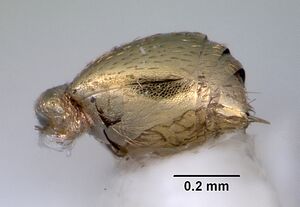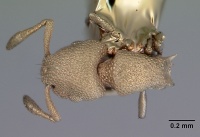Stereomyrmex anderseni
| Stereomyrmex anderseni | |
|---|---|

| |
| Scientific classification | |
| Kingdom: | Animalia |
| Phylum: | Arthropoda |
| Class: | Insecta |
| Order: | Hymenoptera |
| Family: | Formicidae |
| Subfamily: | Myrmicinae |
| Tribe: | Crematogastrini |
| Genus: | Stereomyrmex |
| Species: | S. anderseni |
| Binomial name | |
| Stereomyrmex anderseni (Taylor, 1991) | |
Taylor (1991) - The holotype was taken by pitfall trap in sclerophyll woodland on brown sand, dominated by Eucalyptus miniata and E. tetrodonta, with under-story of annual grasses (mostly Aristida sp.) and the leguminous scrub Bossiaea bossioides. Other ant genera present (identified by Andersen) included Rhytidoponera (4 spp.), Crematogaster (4 spp.), Meranoplus (5 spp.), Monomorium (6 spp.), Tetramorium (4 spp.), Iridomyrmex (6 spp.), Camponotus (5 spp.), and Polyrhachis (6 spp.). The most abundant species included Iridomyrmex sanguineus (Forel), Monomorium and Pheidole spp., and Paratrechina sp. aft. minutula Forel (A. N. Andersen pers comm.).
Identification
Taylor (1991) - S. anderseni is readily distinguished from Stereomyrmex dispar by its much smaller size, very different petiolar and postpetiolar structure, and pale colour.
Distribution
Latitudinal Distribution Pattern
Latitudinal Range: -15.14722222° to -20.5°.
| North Temperate |
North Subtropical |
Tropical | South Subtropical |
South Temperate |
- Source: AntMaps
Distribution based on Regional Taxon Lists
Australasian Region: Australia (type locality).
Distribution based on AntMaps
Distribution based on AntWeb specimens
Check data from AntWeb
Countries Occupied
| Number of countries occupied by this species based on AntWiki Regional Taxon Lists. In general, fewer countries occupied indicates a narrower range, while more countries indicates a more widespread species. |

|
Estimated Abundance
| Relative abundance based on number of AntMaps records per species (this species within the purple bar). Fewer records (to the left) indicates a less abundant/encountered species while more records (to the right) indicates more abundant/encountered species. |

|
Biology
Castes
Images from AntWeb
  
| |
| Holotype of Stereomyrmex anderseni. Worker. Specimen code casent0172304. Photographer April Nobile, uploaded by California Academy of Sciences. | Owned by ANIC, Canberra, Australia. |
Nomenclature
The following information is derived from Barry Bolton's Online Catalogue of the Ants of the World.
- anderseni. Willowsiella anderseni Taylor, 1991a: 285, figs. 6-9 (w.) AUSTRALIA (Western Australia).
- Type-material: holotype worker.
- Type-locality: Australia: Western Australia, Kimberley Dist., King Edward River, 1.vi.1988 (A.N. Andersen).
- Type-depository: ANIC.
- Combination in Stereomyrmex: Bolton, 2003: 273.
- Status as species: Bolton, 1995b: 424; Bolton, 2003: 273.
- Distribution: Australia.
Unless otherwise noted the text for the remainder of this section is reported from the publication that includes the original description.
Description
Worker
TL ca. 2.0; HL 0.51; HW (across eyes) 0.46, (maximum behind eyes) 0.47; CI 92; SL 0.29; SI 62; PW 0.35; WL 0.58; midline length of petiolar node 0.14; petiolar node width 0.31; midline length of postpetiole 0.15; postpetiole width 0.33. Smaller than Stereomyrmex dispar, with different proportions. General features as in the accompanying figures.
Head expanded posterolaterally; anterior part of frons somewhat inflated; clypeus inflated anteromedially, median anterior border transverse, shallowly concave, abruptly reflexed ventrally and projecting forwards to slightly overhang the closed mandibles. Mandibles 5-toothed, apical tooth the largest and most acute, the others subequal in size, diminishing slightly from apex. Antennal club indistinctly 3-jointed, the two apical segments enlarged.
Pronotal shoulders narrowly rounded in dorsal view, semi-epaulate. Pronotum on each side with an obtuse ridge extending dorsally from its ventrolateral extremity to the shoulder, so that the anterolateral and lateral sections of the sclerite are more-or-less separated. Dorsum and sides of mesosoma lacking sutures, except for a short ventral section of the promesonotal suture on each side below the spiracle. Propodeal spines short but acute, posterodorsolaterally directed, slightly curved; each subtended by an anterodorsal carina, which defines the lateral margin of the propodeal dorsum; infradental lamellae small, rounded. Propodeal spiracle very small, situated near the middle of the relevant section of the lateral wall of the mesosoma.
Petiole and postpetiole as illustrated; the former much less bulky than in S. dispar, strongly transverse in dorsal view. Postpetiole similarly transverse, shorter at midline than petiole. Petiolar peduncle extremely short, slender; the spiracles minute, each surmounted by a strong angular process, which is clearly visible and approximately right-angular in dorsal view. Base of gaster quite deeply emarginate in dorsal view, closely reflecting posterior outline of postpetiole. Gaster somewhat broad and flattened, especially anteriorly; in side view more-or-less triangular, with apex anteriorly directed. Sting moderately strong, blade-like, without apical appendage.
Pilosity sparse; a few relatively long hairs on clypeus and mandibles, and on apex and underside of gaster; clypeus with a median and 2 lateral setae on anterior margin; shorter hairs sparse on underside of head. Fine pubescence everywhere moderately abundant. Sculpturing vaguely, densely foveolate on head, mesosoma and nodes; less distinct and more shining posteriad; overall somewhat reminiscent of some Crematogaster species. Gaster dorsally vaguely shagreened, dully shining. Colour bright yellow-brown; eyes black; mandibular teeth dark brown; gastral dorsum darkly infuscated, darkest medially.
Type Material
Western Australia: Kimberley District: King Edward River (15°08’50"S; 126°08’40"E). Holotype worker (1 June, 1988, A. N. Andersen). Deposited in Australian National Insect Collection (type number 7867). The holotype has been gold-palladium coated for scanning electron microscopy. It was unfortunately damaged in a laboratory accident, but its major parts are complete.
- Willowsiella anderseni Taylor, 1991: Holotype, worker, King Edward River, Western Australia, Australia, Australian National Insect Collection.
References
- Heterick, B.E. 2021. A guide to the ants of Western Australia. Part I: Systematics. Records of the Western Australian Museum, Supplement 86, 1-245 (doi:10.18195/issn.0313-122x.86.2021.001-245).
- Heterick, B.E. 2022. A guide to the ants of Western Australia. Part II: Distribution and biology. Records of the Western Australian Museum, supplement 86: 247-510 (doi:10.18195/issn.0313-122x.86.2022.247-510).
- Taylor, R.W. 1991a. Notes on the ant genera Romblonella and Willowsiella, with comments on their affinities, and the first description of Australian species. Psyche 97 (1990): 281-296. [26.ii.1991.] (page 285, figs. 6-9 worker described)
References based on Global Ant Biodiversity Informatics
- Fisher J., L. Beames, B. J. Rangers, N. N. Rangers, J. Majer, and B. Heterick. 2014. Using ants to monitor changes within and surrounding the endangered Monsoon Vine Thickets of the tropical Dampier Peninsula, north Western Australia. Forest Ecology and Management 318: 7890.
- Taylor, R. W. 1991. Notes on the ant genera Romblonella and Willowsiella, with comments on their affinities, and the first descriptions of Australian species (Hymenoptera: Formicidae: Myrmicinae). Psyche (Cambridge) 97: 281-296.

